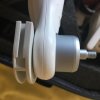Hi together!
Bought a P3A recently for ~350$ and it arrived with quite long&deep stress cracks on 3 of 4 Arms.
The seller didn't notice and never crashed it according to his own words except for tipping it over a few times on the landing procedure (he said that the landing procedure/turning motors off was different in previous phantoms and that was the reason).
None the less it pissed me off quite badly and he agreed to refund me no questions asked but i came up compromising and he arranged a new shell that will arrive any day.
Since this seems to be a normal Problem with the Phantom 3's i really would like to enforce the new case and am thinking about laminating the arms with 25g/m² Fiberglass-Meshing + Epoxiresin.
Would anyone advice against me doing this kind of modification for whatever reason i might not be aware of?
The Epoxyresin is a 2-Part one, which you probably would call Top-Coat, it is meant for clear laminates on Boats or castings as it should have near zero shrinkage.
It is also quite clear when it is hardened as i've noticed.
Was thinking about a Carbonfibre-Mesh at the beginning (For the looks!) but my searches didn't turn up with anything lighter than 80g/m², which is why i settled on the 25g/m² for now at it's easily accessable from a local model making shop.
Excuse my Grammar if there are any Typos I'm from Germany and English isn't my native language.
P.S. Looking at the dissassembly i really am not looking forward to this, just so f-ing many different screws involved in the process, and this is coming from a tech savvy person

Cheers.















